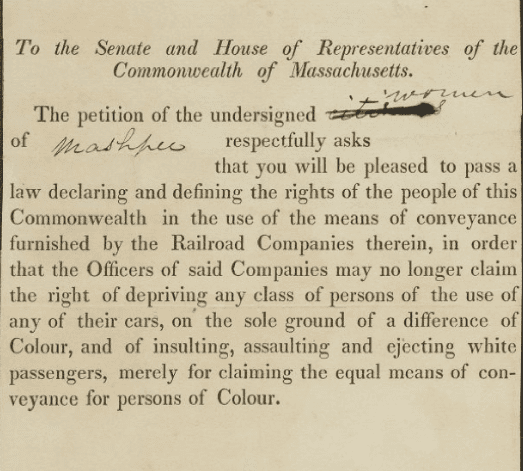EVENT
Desegregation of Massachusetts Railways

Over 100 years before Claudette Colvin and Rosa Parks refused to move to the back of the bus, a heated fight to desegregate transportation took place in Massachusetts. Passenger railroads, introduced in the state in 1836, required free people of color to ride in what was called the “dirt car” and “jim crow car,” and did not allow their white companions to join them. The only exception was if a slaveholder chose to keep their servant with them—revealing the level of animosity directed specifically at free people of color.
Outrage at the policy bubbled up, reaching new heights in 1841 when David Ruggles, an Afro-American anti-slavery activist was dragged from the train for sitting in a white car. This was followed by a series of incidents, including Frederick Douglass being carried out of his car by 8 railway workers; Mrs. Mary Newhall Green, the secretary of the Lynn Anti-Slavery Society, being dragged out with a baby in her arms and her husband badly beaten; and Charles Remond, the renowned anti-slavery advocate just returned from the World Anti-Slavery Convention in London, being moved to the “dirt car” with his white companions forbidden to join.
Newspapers across the state reported these and other incidents, causing a public outcry. Anti-slavery societies responded, in part, with calls to boycott the railways and a statewide petition campaign demanding that Massachusetts pass legislation desegregating railways and protecting white passengers who defend passengers of color. For two years, legislation failed to pass, but due to sustained public outrage and the threat that new legislation introduced in the coming year would pass, Eastern Railway voluntarily changed their policy in 1842. (1)
As active members in the Massachusetts Anti-Slavery Society and subscribers to its main newspaper, The Liberator, many Wampanoags were fully aware of the political organizing taking place. In 1842 petitions from both Mashpee and Nantucket joined that of over 60 from across the state calling for action from the Massachusetts legislature to desegregate railways.
Mashpee Wampanoags submitted two petitions—one likely initiated by Cynthia Conant Attaquin containing 13 women’s signatures, and one likely initiated by William Holland with 13 men’s signatures including that of Cynthia’s husband, Solomon Attaquin. (2)(3)
On Nantucket, 158 men and women—Afro-American, Indigenous, and white—signed a single petition supporting the campaign. (4)
1. Ruchames, Louis. “Jim Crow Railroads in Massachusetts.” American Quarterly, Vol 8, No.1 (Spring 1956) p. 61-75(https://www/jstor.org/stable/2710298)
2. Digital Archive of Massachusetts Anti-Slavery and Anti-Segregation Petitions, Massachusetts Archives, Boston MA, 2015, "Senate Unpassed Legislation 1842, Docket 11057, SC1/series 231, Petition of Cynthia Attaquin" , Harvard Dataverse, V5 (https://doi.org/10.7910/DVN/8NR1L)
3. Digital Archive of Massachusetts Anti-Slavery and Anti-Segregation Petitions, Massachusetts Archives, Boston MA, 2015, "Senate Unpassed Legislation 1842, Docket 11057, SC1/series 231, Petition of William Holland", Harvard Dataverse, V4 (https://doi.org/10.7910/DVN/Q607G)
4. Digital Archive of Massachusetts Anti-Slavery and Anti-Segregation Petitions, Massachusetts Archives, Boston MA, 2015, "Senate Unpassed Legislation 1842, Docket 11057, SC1/series 231, Petition of Josiah Macy", Harvard Dataverse, V4 (https://doi.org/10.7910/DVN/ZAFVL)
Image: Mashpee Women petition for desegretated railways in Massachusetts (Massachusetts Archives. https://iiif.lib.harvard.edu/manifests/view/drs:47339517$228i)



